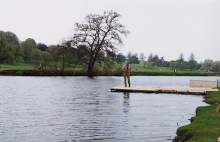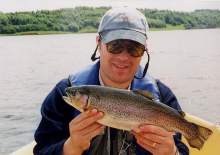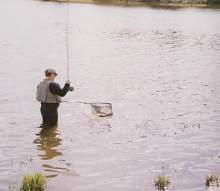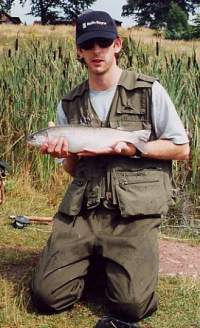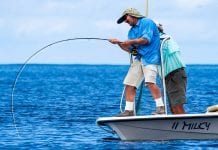CASTING
This is an area where most ‘would be fly anglers’ are put off – “it looks too complicated” or ” I’ll never manage that!” are common statements. However I would say that within an hour or so of tuition from a recognised instructor or established fly angler, you will be casting reasonably well. I am not going to give any more advice on this area other than visit your local fishery and sign up for a couple of lessons. It may cost you £ 20-£ 30 but you will find it money well spent and it will ensure that you have the best start to flyfishing you could get and you won’t end up ‘thrashing the water into a foam’ each time you go fishing. Also, by doing this it allows you to give flyfishing a try before you spend money on new gear. You never know, you may not like this side of our special sport! Oh, and by the way, don’t get thinking that you have to cast 30-40 yards to catch fish. Most stillwater trout are caught close in to the bank side!
|
|
| |
No retrieve – This is mainly used when using dry flies or when you are allowing the fly to drift in the wind or current. This can be a deadly method if you get the pattern (type of fly) and presentation correct, the fish will see the fly as if under natural conditions and, hopefully, react accordingly. Watch the end of the fly line for takes when using buzzers or nymphs below the surface.
Figure of eight retrieve – This is a very slow retrieve and where the angler folds the line in a ‘figure of eight’ shaped loop in the palm of his hand. It gives the fly a very slow natural action and is mainly used when fishing buzzers or nymphs although it can be very good when used with a dry fly such as hoppers.
Pull/jerk – This is very common when fishing lures or larger nymphs as it gives the fly a slow ‘jerky’ presentation. It involves pulling sharply on the line, bringing in short sections a bit at a time.
|
|
| |
As I mentioned previously, there are many other types of retrieve but I have listed the most common types. Sometimes a collection of the above may work i.e. start with a ‘Pull’ then try ‘Figure of eight’, then a ‘fast retrieve’ followed by ‘no retrieve’ – believe me it works very well! Try them all and you will soon come up with what you feel are the best methods on a particular occasion.
PLAYING AND LANDING YOUR FISH
So you’ve cast your fly out into the water, the retrieve you chose was perfect and you’ve hooked a trout! Firstly get ready for a great fight as trout fight very hard and because you haven’t got lots of weight on your line you tend to feel every ‘thump’ and ‘lunge’! You have 2 ways to get your hooked fish into the waiting net:
Use the reel – This is quite straightforward method, you just wind the spare line onto the reel and then play the fish off the reel into the waiting net.
Pull the line through your hands – This is where you ignore the reel and pull the gained line through your fingers, which are holding onto the rod. If the fish gains line you just let some line run through your fingers and vice versa when you are winning! The only potential problem with this method is if you stand on the spare line or get it wrapped around a bramble bush, (I’ve been there!). I personally prefer this method as I feel more in control. However I would suggest that you try both and use the one you are most comfortable.
|
|
| |
COOKING YOUR CATCH
If your ticket allows then you can kill the allocated amount of fish and then you can take them home to show the wife or family, (The best bit!!). Cooking your catch is one of the great pleasures of trout fishing and there are many excellent ways and recipes to try out. I’ll save my favourites for a later article but get the cook books out put the ‘pinny’ on! Trout are also great cooked on the barbeque and you can impress/bore your friends and family with your catch details and don’t forget to tell them about ‘the one that got away!’
RECOMMENDED READING
There are loads of good books and magazines full of flyfishing information. My flyfishing bible is a book written by Charles Jardine, a very talented and famous fly fisherman. It is called The Sotheby’s Guide to flyfishing and is published by Doring Kindersley and costs approx £ 20. Check out www.bol.com for current deals and for other titles.
|
|
| |
Internet – Great sites, like FISHINGmagic.com, offer you lots of exciting information and advice. Just type ‘flyfishing’ into your search engine and you will find loads of new sites to explore.
OTHER SPECIES
I know that I have solely talked about catching trout on the fly, however they are not the only fish you can target. Every year trout anglers catch loads of coarse fish ‘by mistake’ whilst trying to catch trout. All coarse fish can be caught on a fly especially perch, pike, chub, rudd and carp. It is a fast growing and exciting way to target coarse fish and once you have caught a good fish on fly you won’t want to get your coarse gear out again!!
SUMMARY
So, there you have it! As I stated that the beginning of the piece – I do not claim to be a flyfishing expert and this is not a definitive guide. However I hope that it has given you a few ideas on how to start and to put a few fish on the bank.
flyfishing is a great way to fish, it is available to all of us and you don’t need mountains of expensive gear to enjoy it. You can also keep the wife or family happy by giving them some mouth watering cooked trout to eat.
Give it a try and I look forward to seeing you on the bank. I’m the one untangling my leader from the bushes behind you!!!
Good fishing!










